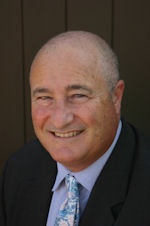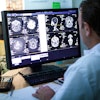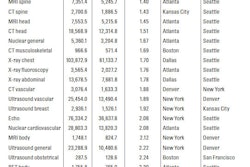
It was a little after 4:00 a.m. as I backed out of my driveway. Pitch-black and raining.
But from the moment I merged onto U.S. Highway 101 heading south into Los Angeles to give a grand rounds presentation, there were other cars on the road. By 5:30 a.m., as I approached the major arteries of the L.A. freeway system, the road was crowded.
 |
| Healthcare business and legal affairs expert Mark F. Weiss. |
Many of the drivers, I suppose, were headed to factory jobs that start at 6:00 a.m.
They make the same drive, day after day. Every day they go through the same start, middle, and end of work -- punctuated only occasionally by some special change in schedule.
That morning, as I gave my lecture, I commented on the experience to the audience, medical residents and attending staff, and asked: Are radiologists going each day to a factory, too, just a factory of a different kind? Do they have the same factory-worker mentality -- the mentality that what they do can be done by many others in much the same way? Sure, the "reward" radiologists receive is quantitatively different, but is the situation qualitatively the same?
I asked my audience whether radiology groups are simply units of production within the larger factory of the hospital. Does the group view itself simply as a "service" provider -- delivering the same, commodity service as any other radiology group in any other community? Does it believe that other groups, whether practicing nearby or at a distance, whether delivering services personally or virtually, are competent potential competitors for the provision of services at your hospital? Has the group's workload grown but its collections failed to keep pace, creating what I term an increasing workload/reimbursement gap? And has the group determined that it must accept the increasing gap, and the hospital's unwillingness to stem it by way of sufficient stipend support -- just another way of working "for what they give me?"
To break free of this kind of thinking, either at the individual or group level, requires both a change in mentality and strategic action.
A mind is a terrible thing to waste
There's very little that anyone can guarantee in life. But one thing is certain: If radiologists believe they provide a commodity service, they have little to no upside in their future. Grab the lunch pail and head to the factory. Form a union and protect against someone else doing the job for less. Because that's the problem with commodities: Sellers are relegated to competing on the basis of price -- and someone will always do it for less, as price is the easiest basis on which to compete.
To be fair, part of this commodity-think mentality is fostered by the high level of collegiality within the medical profession, an otherwise very positive attribute. However, recognition and honor of a colleague's similar training and even of his or her medical skills does not have to equate to the belief that two radiologists, or two radiology groups, deliver the same value to customers, i.e., facilities, referring physicians, and patients. The failure to focus on that value package distinguishes the commodity group from the strategic group.
There's a dark little secret lurking just under the level of radiologist-as-commodity: The healthcare system is approaching a tipping point at which commodity status might largely remove radiologists, at least as they presently practice, from the hospital-based equation due to a convergence of healthcare paradigms, technologies, and business models.
Healthcare paradigms
As anyone who deals with hospital administrators on a regular basis will say, these administrators often take the position that radiology services are a commodity to be obtained at the lowest possible cost. Cafeteria services? Check. Laundry services? Check. Radiology services? Check.
Healthcare assumptions are included in the present push for healthcare "reform." Government-controlled or -financed healthcare programs ultimately lead to cost cutting, which leads policymakers to consider alternative means of obtaining services, including the use of alternative, i.e., nonphysician, providers.
Technology
Technology is converging on the same point, too. Advances in computerization have led to the growth of teleradiology. Technology will, sooner or later, lead to advances in diagnostics by computer, as opposed to diagnostics aided by computer. Who will be the human interface -- radiologists or paraprofessionals? As to the issue of interventional radiology, we already know that competitors from cardiology and surgery are ready to carve up the remaining pieces of radiology groups' clinical functions.
Business models
Over the past decade, the radiology delivery business model has changed, first from being fully onsite to onsite aided by teleradiology. And the teleradiology model has morphed from the provision of backup, nighttime services, to the provision of anytime final read services.
In fact, in some instances, teleradiology businesses are seeking to take over full control of a hospital's imaging needs, providing some staffing onsite and handling the rest remotely. As the intertwining of healthcare assumptions, technology, and business models continues, the need for radiologists may drop, leading to an oversupply and further downward pressure on compensation.
Not possible? Although not a perfect analogy, look just across medical staff department lines: See the arguments about the differences, or lack thereof, between doctor-delivered anesthesia and anesthesia delivered by certified registered nurse anesthetists (CRNAs). Or, make an appointment to see an internist at a medical group on an HMO's panel; the chances are great that a physician's assistant will perform the exam.
Of course, in the context of internal medicine, some physicians have removed themselves completely from the managed care model, and even from the indemnity insurance model, creating "concierge" medical practice. And even within the specialty of radiology, some physicians and groups have developed freestanding imaging facilities in which they compete on many levels, notably the level of patient service and the level of responsiveness to referring physicians.
Strategic action
Although a change in mindset is required to eliminate commodity-level thinking, so, too, is action. Among the steps that radiologists must take is performing an honest assessment of their present situation and developing a model of their ideal future. This is a strategic process that differs completely from making incremental plans based on the present reality: It's breaking the mold and creating a new one.
If a radiologist's ideal future is to include hospital-based services, it must necessarily include the creation of an "experience monopoly," a standard of service and interaction that no one else can duplicate -- would-be competitors might not even understand what is being done -- making the particular radiology group the only logical choice for the relationship.
There are many aspects to creating this level of service. It's not simply the delivery of high-quality patient care. That's expected, and it's only the "price of admission" -- a small but important part of the overall picture.
Creating this level of service includes the manner in which the group's providers interact with the patients, the group and its physicians interact with the hospital, and the radiologists interact with referring physicians. Too often, radiologists -- in fact, all hospital-based physicians -- look at these interactions as separate, although the reality is that they are all related.
For example, the overall relationship with a referring physician -- let's say, an orthopedic surgeon -- affects the care provided to a particular patient. So, what can be done to create a relationship with that surgeon that takes the radiology group from commodity status to that of a monopoly? It includes fostering both a personal and a professional relationship with the surgeon and his/her office, proactively making the experience of working with the group a delight.
To this end, the group can ask itself: How are requests for consults handled? How are these consult requests acknowledged? How are reports delivered? How are the group's radiologists available for follow-up consultation? What efforts are taken outside of the strictly professional, patient-care focus that will advance the overall relationship?
This means that the group must interact with its own members and nonphysician employees in a way to foster the delivery of that level of service. It also means that the group must find ways to monitor, measure, and demonstrate the value that it is creating.
And, as the relationship between the group and the hospital and its administrators impacts the ability of the group to deliver that level of service (think, for example, of the hospital's willingness to acquire the equipment and technology that the group needs to achieve its goals), the group must cement that relationship as well.
After all, the creation of a monopoly comes back to mean that the radiology group has removed itself from competition -- it no longer provides a commodity service -- and has become the only group considered by its customers. That means a dramatically increased willingness on the part of the hospital to provide the necessary level of stipend support.
The time to get started is now. (OK, it was really yesterday.). And, yes, radiology groups include colleagues who don't change. But as Gen. Eric Shinseki, chief of staff, retired U.S. Army and present secretary of the U.S. Department of Veterans Affairs said, "If you don't like change, you're going to like irrelevance even less."
By Mark F. Weiss
AuntMinnie.com contributing writer
April 13, 2010
Mark F. Weiss is an attorney who specializes in the business and legal issues affecting radiology and other physician groups. He holds an appointment as clinical assistant professor of anesthesiology at University of Southern California's Keck School of Medicine and practices nationally with the Advisory Law Group, a firm with offices in Los Angeles and Santa Barbara, CA. Mr. Weiss provides complimentary educational materials to our readers. Visit www.advisorylawgroup.com for his free newsletter. He can be reached by e-mail at [email protected].
Related Reading
The Profit Center: Part 11 -- Thriving despite (so-called) healthcare reform, January 13, 2010
The Profit Center: Part 10 -- Taking on risk with dubious reward, January 4, 2010
The Profit Center: Part 9 -- Securing customer satisfaction, November 11, 2009
The Profit Center: Part 8 -- Deploy the power of persuasion, October 30, 2009
Copyright © 2010 Mark F. Weiss



















